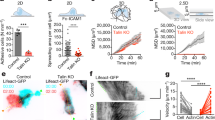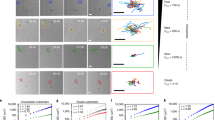Abstract
Migration of cells in higher organisms is mediated by adhesion receptors, such as integrins, that link the cell to extracellular-matrix ligands, transmitting forces and signals necessary for locomotion1–4. Whether cells will migrate or not on a given substratum, and also their speed, depends on several variables related to integrin–ligand interactions, including ligand levels5,6, integrin levels7–9, and integrin–ligand binding affinities10–12. These and other13 factors affect the way molecular systems integrate to effect and regulate cell migration. Here we show that changes in cell migration speed resulting from three separate variables—substratum ligand level, cell integrin expression level, and integrin–ligand binding affinity—are all quantitatively predictable through the changes they cause in a single unifying parameter: short-term cell–substratum adhesion strength. This finding is consistent with predictions of a mathematical model for cell migration14. The ligand concentration promoting maximum migration speed decreases reciprocally as integrin expression increases. Increases in integrin–ligand affinity similarly result in maximal migration at reciprocally lower ligand concentrations. The maximum speed attainable, however, remains unchanged as ligand concentration, integrin expression, or integrin-ligand affinity vary, suggesting that integrin coupling with intracellular motors remains unaltered.
This is a preview of subscription content, access via your institution
Access options
Subscribe to this journal
Receive 51 print issues and online access
$199.00 per year
only $3.90 per issue
Buy this article
- Purchase on Springer Link
- Instant access to full article PDF
Prices may be subject to local taxes which are calculated during checkout
Similar content being viewed by others
References
Hynes, R. O. Cell 69, 11–25 (1992).
Cheresh, D. A. Adv. Mol. Cell Biol. 6, 225–252 (1993).
Schwartz, M. A., Schaller, M. D. & Ginsberg, M. H. Annu. Rev. Cell Dev. Biol. 11, 549–599 (1995).
Lauffenburger, D. A. & Horwitz, A. F. Cell 84, 359–369 (1996).
Goodman, S. L., Risse, G. & van der Mark, K. J. Cell Biol. 109, 799–809 (1989).
DiMilla, P. A., Stone, J. A., Quinn, J. A., Albelda, S. A. & Lauffenburger, D. A. J. Cell Biol. 122, 729–737 (1993).
Bauer, J. S., Schreiner, C. L., Giancorti, F. G., Ruoslahti, E. & Juliano, R. L. J. Cell Biol. 116, 477–487 (1992).
Giancotti, F. G. & Ruoslahti, E. Cell 60, 849–859 (1990).
Keely, P. J., Fong, A. M., Zutter, M. M. & Santoro, S. A. J. Cell Sci. 108, 595–607 (1995).
Duband, J.-L., Dufour, S., Yamada, S. S., Yamada, K. M. & Thiery, J. P. J. Cell Sci. 98, 517–532 (1991).
Kuijpers, T. W. et al. J. Exp. Med. 178, 279–284 (1993).
Huttenlocher, A., Ginsberg, M. H. & Horwitz, A. F. J. Cell Biol. 134, 1551–1562 (1996).
Huttenlocher, A., Sandborg, R. R. & Horwitz, A. F. Curr. Opin. Cell Biol. 7, 697–706.
DiMilla, P. A., Barbee, K. & Lauffenburger, D. A. Biophys. J. 60, 15–37 (1991).
Regen, C. M. & Horwitz, A. F. J. Cell Biol. 119, 1347–1359 (1992).
Palecek, S. P., Schmidt, C. E., Lauffenburger, D. A. & Horwitz, A. F. J. Cell Sci. 109, 941–952 (1996).
Bajt, M. L., Loftus, J. C., Gawaz, M. P. & Ginsberg, M. H. J. Biol. Chem. 267, 22211–22216 (1992).
Frelinger, A. L., Du, X., Plow, E. F. & Ginsberg, M. H. J. Biol. Chem. 266, 17106–17111 (1991).
Powers, M. J., Rodriguez, R. E. & Griffith, L. G. Biotechnol. Bioeng. (in the press).
Oliver, T. N., Lee, J. & Jacobson, K. Semin. Cell Biol. 5, 139–147 (1994).
Abercrombie, M., Heaysman, J. E. M. & Pegrun, S. M. Exp. Cell Res. 59, 393–398 (1970).
Marks, P. W., Hendey, B. & Maxfield, F. R. J. Cell Biol. 112, 149–158 (1991).
Jay, P. Y., Pham, P. A., Wong, S. A. & Elson, E. L. J. Cell Sci. 108, 387–393 (1995).
Wessels, D., Vawter-Hugart, H., Murray, J. & Soll, D. R. Cell Motil. Cytoskeleton 27, 1–12 (1994).
Cary, L. A., Chang, J. F. & Guan, J. J. Cell Sci. 109, 1787–1794 (1996).
Varner, J. A. & Cheresh, D. A. Curr. Opin. Cell Biol. 8, 724–730 (1996).
Langer, R. & Vacanti, J. Science 260, 920–926 (1993).
Argraves, W. S. et al. J. Cell Biol. 105, 1183–1190 (1987).
Loftus, J. C. et al. Science 249, 915–918 (1990).
Dunn, G. A. Agents Actions (suppl.) 22, 14–33 (1983).
Author information
Authors and Affiliations
Rights and permissions
About this article
Cite this article
Palecek, S., Loftus, J., Ginsberg, M. et al. Integrin-ligand binding properties govern cell migration speed through cell-substratum adhesiveness. Nature 385, 537–540 (1997). https://doi.org/10.1038/385537a0
Received:
Accepted:
Issue Date:
DOI: https://doi.org/10.1038/385537a0
This article is cited by
-
Efficient deformation mechanisms enable invasive cancer cells to migrate faster in 3D collagen networks
Scientific Reports (2022)
-
A brief overview on mechanosensing and stick-slip motion at the leading edge of migrating cells
Indian Journal of Physics (2022)
-
Collective migration during a gap closure in a two-dimensional haptotactic model
Scientific Reports (2021)
-
Polyrotaxanes as emerging biomaterials for tissue engineering applications: a brief review
Inflammation and Regeneration (2020)
-
Biomarkers to quantify cell migration characteristics
Cancer Cell International (2020)
Comments
By submitting a comment you agree to abide by our Terms and Community Guidelines. If you find something abusive or that does not comply with our terms or guidelines please flag it as inappropriate.



